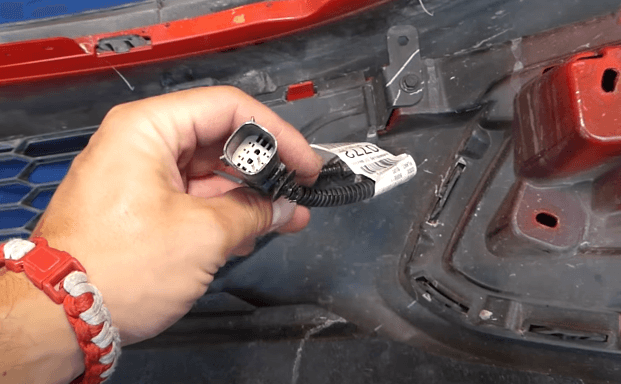Understanding how these Ambient air temperature sensors work can help you choose the right one. These sensors are used in cars, weather stations, and HVAC systems. They provide accurate temperature readings, ensuring optimal performance and comfort. Whether you’re a tech enthusiast or someone curious about how everyday devices function, ambient air temperature sensors play a vital role in our lives.
Let’s explore their importance, functionality, and where you might encounter them. This guide will help you appreciate the technology behind these essential devices.

Introduction To Ambient Air Temperature Sensor
An Ambient Air Temperature Sensor measures the temperature of the air around it. It helps vehicles and HVAC systems adjust performance and improves efficiency and comfort by providing accurate temperature readings.
Ambient air temperature sensors are essential in modern technology. They monitor the temperature of the surrounding air and play a vital role in various applications. They ensure systems operate efficiently and safely.
Purpose And Importance
Ambient air temperature sensors serve many purposes. They help in climate control systems, are used in automotive applications, maintain the comfort of vehicle cabins, protect electronic devices, and prevent overheating by monitoring temperatures. In weather stations, they provide accurate data, which helps in forecasting. In industrial settings, they control processes. This ensures product quality and safety, and understanding their importance helps appreciate their widespread use.
Basic Functionality
Ambient air temperature sensors work in simple ways. They measure the air temperature around them. They convert this measurement into an electrical signal. This signal is then read by a control unit. The control unit uses this data to make decisions. There are different types of sensors. Some use resistance changes to measure temperature. Others use voltage differences. They all provide accurate and reliable data. This data is critical in maintaining optimal conditions. These sensors are easy to integrate into systems. They are vital in ensuring efficient operation. Understanding their basic functionality helps you choose the right sensor for your needs. “`
Working Principle
Understanding the working principle of an Ambient Air Temperature Sensor is crucial for anyone looking to optimize their use of this technology. These sensors are essential in various applications, from automotive systems to climate control in smart homes. But how do they actually work? Let’s break it down step by step.
Sensor Components
The core of the Ambient Air Temperature Sensor is its components. Think of these as the building blocks that make the sensor function. Typically, the sensor includes a thermistor, which is a type of resistor whose resistance varies significantly with temperature.
Another key component is the housing, which protects the thermistor and ensures it accurately measures the surrounding air temperature. A connector also plays a role, linking the sensor to the electronic control unit (ECU) in a car or another system.
Data Collection Process
So, how does the sensor collect data? It’s straightforward yet fascinating. When the air temperature changes, the resistance of the thermistor changes. This change in resistance is converted into an electrical signal.
The electrical signal is then sent to the ECU, which interprets it to understand the ambient temperature. This data can be used for various purposes, from adjusting your car’s climate control to optimizing your HVAC system’s performance at home.
Ever noticed how your car’s air conditioning adjusts on a particularly hot day? The sensor at work provides real-time data to keep you comfortable.
Have you ever wondered how accurate these sensors are? Most modern sensors are incredibly precise, often within a degree or two of the actual temperature. This precision is crucial for systems that rely on accurate temperature readings to function correctly.
Knowing how these sensors work can help you appreciate their role in your daily life. It also makes troubleshooting issues easier. Next time you adjust your car’s climate control or enjoy your perfectly regulated home temperature, you’ll know a tiny but mighty sensor is working behind the scenes.
How has understanding the working principle of Ambient Air Temperature Sensors changed your perspective on everyday technology? Share your thoughts in the comments below!

Impact On Vehicle Performance
The Ambient Air Temperature Sensor plays a crucial role in vehicle performance. It measures the outside temperature, which helps the car’s computer make important decisions. Let’s explore how it affects fuel efficiency and engine optimization.
Fuel Efficiency
The Ambient Air Temperature Sensor directly impacts fuel efficiency. It provides data that helps adjust the air-fuel mixture. In cold weather, engines need more fuel. In warm weather, they need less. Accurate temperature readings help maintain the perfect balance.
Maintaining the right balance means using fuel efficiently. This leads to better gas mileage. Every drop of fuel counts. Accurate temperature data can save money at the pump.
Engine Optimization
Engine optimization relies on accurate temperature readings. The sensor helps adjust ignition timing, which ensures smooth engine performance and reduces wear and tear.
Temperature data helps manage engine cooling systems. It prevents overheating. This extends the engine’s lifespan. Accurate data leads to fewer breakdowns.
The sensor also aids in emissions control. It ensures the engine runs clean, which is better for the environment. Accurate temperature readings make a big difference.
Installation And Maintenance
Installing and maintaining an Ambient Air Temperature Sensor can seem daunting, but with proper guidance, it becomes straightforward. Ensuring that your sensor is correctly installed and well-maintained is crucial for accurate readings and optimal performance. Let’s break down the steps to make this process easier for you.
Proper Placement
Proper placement of your Ambient Air Temperature Sensor is vital. You need to place it in a location where it can measure the air temperature accurately.
Avoid placing it near heat sources such as air conditioning or direct sunlight. These can skew the sensor’s readings and give you false data.
Find a shaded area away from any artificial heat sources. This will help the sensor provide more accurate ambient temperature readings.
Routine Checks
Regular maintenance ensures your sensor performs well over time. Routine checks should be part of your maintenance schedule.
Inspect the sensor for any dirt or debris. Dust and grime can affect its accuracy. A simple wipe with a clean cloth usually does the trick.
Check the connections to ensure they are secure. Loose connections can cause the sensor to malfunction. Tighten any loose wires carefully to avoid damage.
Have you ever experienced a sudden drop in the sensor’s performance? This could be a sign that it needs recalibration. Many sensors come with instructions for recalibration, making it an easy fix.
Have you faced challenges with your sensor’s accuracy? How do you ensure your sensor is always in top shape? Share your thoughts and experiences in the comments below. Your insights could help others facing similar issues.
Common Issues And Troubleshooting
Ambient air temperature sensor issues often cause inaccurate readings. Troubleshooting includes checking for debris and ensuring proper sensor connection. Regular maintenance can prevent sensor malfunctions.
When dealing with ambient air temperature sensors, common issues can pop up that may affect your vehicle’s performance. Understanding these problems and how to troubleshoot them can save you time and money. Let’s break down some of the frequent issues and how you can address them effectively.
Sensor Malfunctions
Sensor malfunctions are a typical problem with ambient air temperature sensors. The sensor may give inaccurate readings if it’s dirty or damaged. Check the sensor for visible dirt or debris. A quick clean can often solve minor issues. If cleaning doesn’t help, the sensor might be broken and need replacement. Be sure to get a sensor compatible with your vehicle model.
Error Diagnostics
Error diagnostics can be tricky, but are crucial for fixing sensor issues. Your vehicle may show a check engine light or other warning signs. Use an OBD-II scanner to read error codes. This tool can provide you with specific fault codes related to the sensor. Once you have the error code, consult your vehicle’s manual or look up the code online. This can guide you on the next steps: cleaning, resetting, or replacing the sensor. Have you ever encountered a sensor issue that seemed impossible to fix? It’s always a good idea to consult a professional if you’re unsure. Don’t let a small sensor malfunction ruin your day. Taking the time to understand and troubleshoot these common issues can make a big difference in your vehicle’s performance. Have you checked your ambient air temperature sensor lately? You might be surprised at what a little maintenance can do.

Advancements In Sensor Technology
Ambient air temperature sensors provide accurate temperature readings. These sensors help in monitoring and controlling environmental conditions. They are essential for various applications, including HVAC systems and weather stations.
Advancements in sensor technology have significantly improved the performance and reliability of ambient air temperature sensors. These sensors play a crucial role in modern vehicles, helping to optimize engine performance and fuel efficiency. Let’s dive into some of the latest developments in this field.
Modern Sensor Types
Today’s ambient air temperature sensors come in various types, each with unique features and benefits. Traditional thermistors have given way to more advanced options like digital temperature sensors. These digital sensors offer higher accuracy and quicker response times. Moreover, some modern sensors are equipped with self-calibration capabilities. This means they can adjust themselves to maintain precision, even in harsh conditions. As a result, they provide more reliable data for your vehicle’s systems.
Integration With Vehicle Systems
Ambient air temperature sensors are now more seamlessly integrated with vehicle systems than ever before. They communicate directly with the engine control unit (ECU) to optimize air-fuel mixture and ignition timing. This integration ensures that your vehicle runs efficiently regardless of external temperature changes. Additionally, these sensors are often linked to climate control systems. They help maintain a comfortable cabin environment by adjusting the air conditioning based on outside temperatures. Have you ever noticed how your car’s AC seems to “know” the perfect temperature for you? That’s the ambient air temperature sensor at work. Think about the last time your vehicle handled a sudden temperature drop smoothly without any hitches. That’s the result of advanced sensor technology working behind the scenes. Have you considered how much more efficient and comfortable your drive has become thanks to these small yet powerful devices?
Comparative Analysis
Ambient air temperature sensors play a crucial role in many systems. From automotive applications to HVAC systems, accurate temperature readings are essential. This section provides a comparative analysis of traditional and modern sensors. We will explore their differences and performance metrics.
Traditional Vs. Modern Sensors
Traditional sensors often rely on simple thermocouples. These devices measure temperature based on voltage changes. They are cost-effective and easy to use. Yet, they may lack precision and responsiveness.
Modern sensors use advanced technology. They incorporate microprocessors and digital interfaces. This allows for more accurate and faster readings. Modern sensors also offer better integration with smart systems.
Performance Metrics
Accuracy is a key performance metric. Traditional sensors might have a variance of ±2°C. Modern sensors can achieve precision within ±0.5°C. This higher accuracy is crucial for sensitive applications.
Response time is another important factor. Traditional sensors may lag in real-time readings. Modern sensors, on the other hand, provide almost instantaneous data. This rapid response is valuable for dynamic environments.
Durability matters in harsh conditions. Traditional sensors can degrade over time. Modern sensors are designed to withstand extreme environments. They often feature robust materials and protective coatings.
Integration capabilities also differ. Traditional sensors usually have limited connectivity. Modern sensors support various communication protocols. This makes them suitable for IoT and smart home applications.
Future Trends
Ambient air temperature sensors will play a crucial role in smart cities. They help monitor environmental changes efficiently. These sensors offer precise data for climate control systems.
In this section, we will dive into the future trends of ambient air temperature sensors. These sensors are becoming increasingly crucial in a world that emphasizes smart technology and automation. Understanding what lies ahead can help you make informed decisions about integrating these sensors into your projects or vehicles.
Innovative Developments
Ambient air temperature sensors are evolving rapidly. New materials like graphene and advancements in nanotechnology are enhancing sensor accuracy and durability. This means better performance in extreme conditions. Wireless technology is another game-changer. Imagine sensors that can relay data in real-time without the need for cables. This could simplify installation and maintenance significantly. Machine learning and AI are also making their way into sensor technology. Sensors could learn from environmental data to predict temperature changes, making your systems even smarter.
Potential Impact On Vehicles
The automotive industry stands to gain a lot from these advancements. Better sensors can improve fuel efficiency by optimizing engine performance based on accurate temperature readings. This is not just about saving money but also reducing your carbon footprint. Imagine driving a car that adjusts its climate control system in real-time. You’d experience a more comfortable ride while the system conserves energy. It’s a win-win for you and the environment. Safety is another area where these sensors can make a big difference. Accurate temperature data can help in the early detection of issues like engine overheating, giving you time to take action before it leads to costly repairs. Have you ever thought about how these sensors could impact autonomous vehicles? Reliable temperature data is crucial for the operation of self-driving cars. They rely on multiple sensors to make decisions, and accurate ambient temperature readings can improve their reliability. What are your thoughts on these future trends? Do you think these advancements will change the way we interact with technology? Share your opinions below!
Frequently Asked Questions
What Is An Ambient Air Temperature Sensor For?
An ambient air temperature sensor measures the outside air temperature. It helps regulate climate control systems in vehicles. This sensor ensures optimal comfort and efficiency.
What Happens When The Ambient Air Temperature Sensor Is Bad?
A bad ambient air temperature sensor can cause incorrect temperature readings. This affects engine performance and fuel efficiency.
How Much To Fix An Ambient Air Temperature Sensor?
Fixing an ambient air temperature sensor typically ranges from $100 to $250. Prices vary by vehicle and location.
How Do I Reset My Ambient Air Temperature Sensor?
Disconnect the car battery for 10 minutes. Reconnect it and start the car. The sensor should reset automatically.
Conclusion
Understanding the ambient air temperature sensor is crucial. It helps keep your vehicle running smoothly. Regular checks ensure accurate readings. Maintain the sensor for better engine performance. Clean it periodically to avoid issues. Replace it if damaged to prevent malfunction.
Your car’s efficiency depends on this small component. Pay attention to its condition. Proper sensor care leads to a healthier vehicle. Enjoy a safer and more reliable drive. Remember, small steps make a big difference. Keep your sensor in top shape for optimal results.

Unlock the full potential of your smart home device. Learn how to connect, automate, and optimize your smart devices for a seamless and convenient lifestyle.

